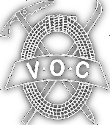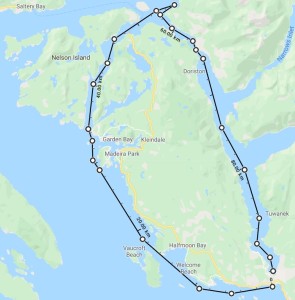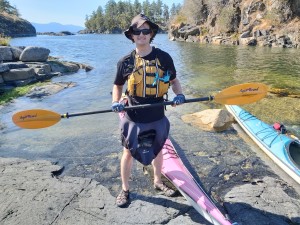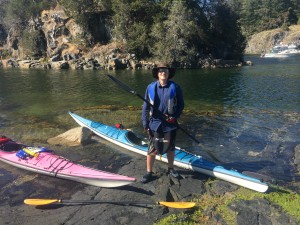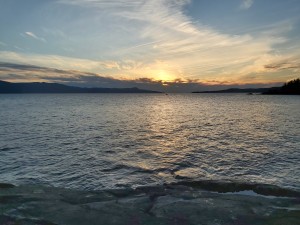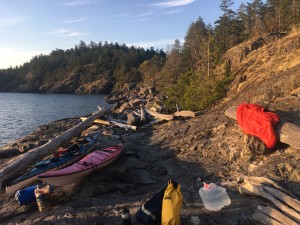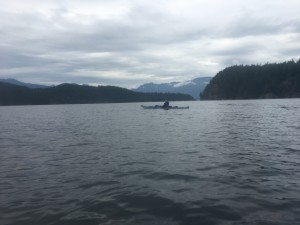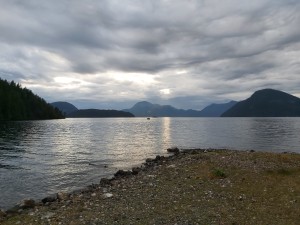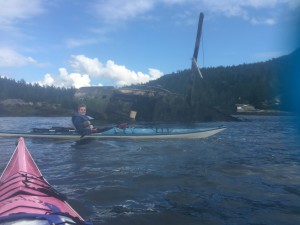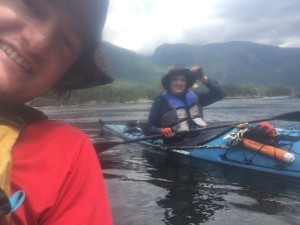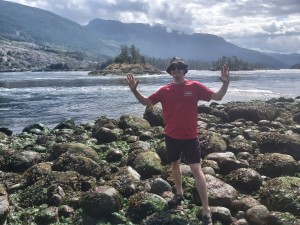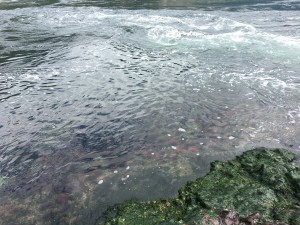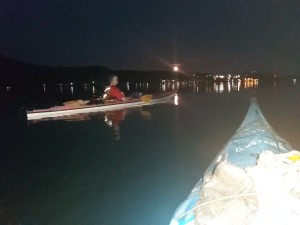For a number of years I have wanted to complete the “Sunshine Coast Kayak Loop” trip, and finally, after my third attempt at organizing the trip, I finally completed it. The trip definitely made for a lot of great memories and stories.
Quinn Ramsay and I, Alex Wharton, are now the third group of people that I know who have completed the loop. I think the previous two groups had an easier time at Sechelt Rapids (Skookumchuck Narrows) than we did. But, the loop is very doable as long as one is cautious at Sechelt Rapids. Read on to hear about our adventure!
The loop consists of paddling north from Sechelt through Georgia Straight past Pender Harbour, then through Agamemnon Channel, and then, finally, through Sechelt Inlet, beginning with Skookumchuck Narrows and Sechelt Rapids. Sechelt Rapids is an area in northern Sechelt Inlet in which the water entering and exiting the inlet is forced into a very shallow and narrow channel. Very sadly, over the years, people have died crossing through Sechelt Rapids. Sechelt Rapids is known around the world as a world class white water kayaking destination. Although it is safe to cross Sechelt Rapids at slack tide, the rapids can be dangerous at high waters and could potentially be fatal for kayakers of our experience to cross at maximum currents. Quinn and I organized our trip such that we would cross Sechelt Rapids on our third and final day.
We started the trip with kayak self rescue practice. Given the high likelihood of rough conditions, especially in Malaspina Strait, we had wanted to practice self rescues the week prior, but we didn’t manage to. The water off of Sechelt was reasonably rough, and that made self rescues challenging and more realistic. We eventually succeeded in our self rescues and were ready to embark on our voyage.
As we were planning the trip, we agreed that there was a fairly high likelihood of us, given the potential for inclement wave, current and wind conditions, not to be able to complete the trip and having to abandon the trip part way through. We had arranged that, should we need an emergency pickup, we could be picked up along the coast between Sechelt and Pender Harbour, in Earls Bay or in Egmont. We thought that likely Egmont was where our highest chance of requiring a pickup was should Sechelt Rapids in Skookumchuck Narrows be too dangerous to cross.
Our paddle towards Beaver Island began with smooth ocean conditions. The wind was in our favour, and, after a few hours of paddling, before we knew it, we were approaching Merry Island and Thormanby Island. As we passed by Thormanby Island, we saw a huge group of seals sun tanning on the rocks. We were careful not to get too close to the seals in order not to frighten them from the rocks into the ocean, which disturbs their needed rest time. We stopped in Smuggler Cove for lunch and noted our fast progress after a late start due to our unscheduled self rescue practice. We also thanked the wind for blowing in the direction that we were heading. Last year I led a VOC kayak trip from Sechelt to Thormanby Island, and on that trip I remember at times not being able to make any forward paddling progress due to the wind blowing against us. In addition, from spending time around Halfmoon Bay over the years, I know that some areas in and around Halfmoon Bay can get too rough to make forward progress in a kayak. That day, we were very grateful for the wind blowing northwest, in the direction we were paddling. After lunch we enjoyed another few hours of paddling to our campsite at Francis Point Provincial Park. That evening we enjoyed a magnificent sunset as we were preparing for bed.
We didn’t know exactly what to expect in Agamemnon Channel, on our second day. We could only imagine that Agamemnon Channel would be calm and wind and wave free, but as neither of us had ever kayaked in Agamemnon Channel, we didn’t know exactly what to expect. We left our campsite a little later than we had planned and were immediately met by large, steep breaking waves. We repeatedly, momentarily, lost sight of one another as we bobbed up and down in the swells. Kayaking through the swells past Pender Harbour and to the entrance of Agamemnon Channel was a little bit frightening, and we were glad that we had practiced self rescues the day before. Had the swells been any larger, I think there would have been a reasonable risk of one of us capsizing and us having to wait on the shore until the waves diminished. We battled through the swells, and as we entered Agamemnon Channel, the swells became smaller and eventually turned into chop before eventually turning into very calm conditions. We stopped for lunch midway into Agamemnon Channel, and as we were eating lunch we heard and saw a baby seal swimming close to our lunch spot in distress. We suspected that the baby seal was searching for its mom, and we hoped that the mom had simply left for a few hours to hunt for fish. Nonetheless, we still felt quite sorry for the baby seal. After lunch we paddled a little farther to exit Agamemnon Channel and, given that we had some extra time before sunset, we paddled around Captain Island and slightly up Jervis Inlet. We spent the night at Little Killam Bay, and before going to bed reiterated our plans for crossing Sechelt Rapids the next day. We enjoyed a pleasant night that never seemed to become truly dark given the extraordinarily bright moon.
We woke excited and nervous about crossing Sechelt Rapids and our long paddle back to Sechelt afterwards. As we approached Sechelt Rapids, we reminded ourselves yet again of our plan to arrive at the rapids a little before 11:20 am, the predicted time of the maximum current, to view the peak of the rapids from shore and then to cross the rapids at about 2:05 pm, the predicted time of slack tide. The rapids vary in strength throughout the month depending on the range of the tides on any given day. The tides were extreme and the rapids were predicted to reach more than twenty knots per hour on the day that we crossed. In addition, we reminded ourselves that slack tide could potentially be up to about half an hour before or after the predicted time of slack tide and that we should try to watch the rapids and cross them when we thought the minimum currents were flowing, not necessarily at exactly 2:05. We had originally planned on leaving our kayaks at Secret Bay and then walking to the Sechelt Rapids viewing platform, but upon landing on a beach near the rapids and talking with some locals, we learned that we had already passed Secret Bay and that it was not feasible to leave our kayaks at Secret Bay, walk to the rapids, wait until slack tide, walk back to Secret Bay and then paddle through the rapids; the walking distance alone between Secret Bay and the rapids was about an hour each way. The locals pointed us towards the best beach to watch the rapids from given that there was no path to the official viewing center from where we were and also reminded us of the dangers of the rapids emphasizing that over the years boaters had passed away crossing the rapids. The locals also reiterated that we should be extremely careful and that it would be possible that they would be the ones initiating a rescue call should we require one.
Feeling a little frightened, we watched the rapids at their peak at about 11:20 and then ate our lunch on the beach as we waited for the rapids to calm. As we waited, we were very impressed to see the abundance of star fish, sea urchins and sea anemones living in Sechelt Rapids; we concluded that the rapids must force huge amounts of nutrients through the rapids and produce a rich ecosystem for sea life. Slack tide is created by changes in tide direction, and it usually occurs about two to three hours after a tide that is leaving the inlet starts to be pulled back into the inlet or a tide that is entering the inlet starts to be pulled out of the inlet. As 2:05 approached, the speed of the current slowly slowed and the rapids slowly reduced in height, and at about 1:40 we felt that we could paddle through the first series of strong currents at points and the succeeding, calm bays. We returned to our kayaks and prepared to cross the rapids. With our adrenaline pumping, we passed through the first serious of sharp points and succeeding bays fairly easily, although it was nonetheless scary to be momentarily somewhat out of control in the fast flowing current at each point. After passing through the first series of bays and points, we had to cross through a serious of points separated by straight edges of shore. It was now about 2:05, and the rapids were still very obviously flowing out of the inlet; they were yet to become stagnant. Therefore, we suspected that the maximum slack tide was yet to come, and we thus decided to wait before continuing onto the next section of the rapids. After several minutes of waiting and watching, at about 2:20, growing worried that the rapids were only getting stronger, we decided to continue on. We struggled not to be pulled into whirlpools as we paddled past the next series of points and straight edges of the rapids. Along the straight edges, we had to hold onto rocks on the shore in order not to be pulled into whirlpools and twisted around in our kayaks, and, despite our best efforts, several times we were pulled into the whirlpools, towards the center of the rapids, and had to fight to return to shore and turn our kayaks the right way around again. We eventually negotiated our way to the largest rapid, directly below the official viewing center. Struggling to hold onto rocks on the shore in order not to be spun around, we decided to wait several more minutes before crossing the most powerful current in the rapids in the hopes that the still scarily strong current would continue to slow. After several minutes of holding onto rocks on the shore, losing our grips, being spun around by the whirlpools and then fighting to turn our kayaks forwards again, our adrenaline was pumping, we were getting worried and it was well beyond 2:05. We decided that the rapids would only get stronger if we continued to wait. I paddled first and every fifteen seconds or so glanced over my shoulder to make sure Quinn was behind me. We had to paddle harder and harder as we got closer and closer to the rapid, and once in the rapid I had to paddle as fast as I could to continue to move forward. Just as I was rounding the corner, I glanced over my shoulder for the last time and saw Quinn yelling and being pulled by a whirlpool towards the center of the rapids. I pulled into the bay past the point, pulled my kayak onto the shore and ran back to the viewing platform, looking for Quinn. I couldn’t see or hear Quinn anywhere in the water, and therefore the only possible outcome that I could think of was that Quinn had managed to escape the whirlpool and had paddled back into one of the calm, safe bays. Unfortunately, cell service was very intermittent, and I spent the next several minutes frantically trying to find a path farther back towards the bay that I expected Quinn to be in, trying to find an area with cell service and asking people on the viewing platform if they had cell service. Eventually, after not being able to reach Quinn or find cell service, I thought that the best option for me was to kayak to the end of the rapids, as I was worried that the rapids were only getting stronger and that I might get stuck if I waited any longer; then, at the end of the rapids I thought that I would try to contact Quinn. The final hundred meters of the rapids were easy to paddle through, and as I approached the end of the rapids, I noticed some people sitting on the shore. I asked them if they had cell service, which they didn’t, but they responded that they had seen what had happened to us and asked if there was anything they could do to help. One man was a very experienced white water kayaker who had been kayak surfing in the rapids for the past several days, and he said that he wouldn’t find it very difficult to kayak over to the bay that we suspected Quinn to be in. I gladly accepted his offer and asked the man, Adrian, to ask Quinn whether he would like to attempt to cross the rapids again or to arrange for a pickup in Egmont. As Adrian paddled back to Quinn, I watched several motor boats struggle to pass through the rapids. To my surprise, as I sat waiting on the shore, the rapids became more and more calm. Eventually, I saw Adrian emerge from the bay and paddle back towards me. Adrian kept glancing over his shoulder and several times turned around and paddled back around the corner only to reemerge shortly afterwards. The only explanation of Adrian’s behaviour I could think of was that Quinn had decided to try to cross the rapids again and that Adrian was coaching Quinn through the rapids. To my great surprise, at this point the rapids were extremely calm and there was hardly any current in them at all. Given how calm the rapids were, I decided to kayak back to Adrian and Quinn, and the three of us easily met in the middle of the rapids, in what would normally have been very rough patches of water. The three of us then easily paddled to the end of the rapids. We thanked Adrian and wished him luck in about three hours when he was planning on surfing in the roughest possible conditions of the rapids. We also remarked at how calm, at the moment, the rapids were. At this point, it was about 3:05, an hour after the predicted time of slack tide, and the rapids were extremely calm; it was impossible to say that water was primarily flowing into or out of the inlet – the water was very stagnant. Relieved that we were both across the rapids and that we were able to continue our trip, we remarked at how we didn’t know that the true time of slack tide could be off of the predicted slack tide time by about an hour, and we also remarked that we should have continued to wait for the rapids to calm and should not have submitted to our fear of the rapids only growing larger as the time went further and further past 2:05. After talking to Quinn, I learned that he had been pulled towards the center of the rapids by a whirlpool, had managed to escape into the bay that we thought he was in, and then had run through the woods looking for cell service. He assumed that I and the onlookers would have thought that he had been sucked underwater and was drowning and that we would try to coordinate a rescue if we didn’t hear from him immediately. He had a lot of cuts on his legs from his bushwhacking to try to get cell service. But, thankfully, despite the slight misadventure and thanks to Adrian’s help, we were both safely across the rapids.
Note: Read the final paragraphs of the trip report for the true reason why we thought slack tide was an hour earlier than it actually was (daylight savings time)!
As our adrenaline slowed, we made slow progress into Sechelt Inlet for the first several kilometers as we fought wind and waves pushing us back towards Skookumchuck Narrows. Eventually, the wind and waves subsided and our pace increased. We were slightly worried that we wouldn’t be able to paddle all the way back to Sechelt that day, but the moon was once again very bright and, along with our headlamps, helped us paddle the final section of the inlet in the dark. As night fell thousands and thousands of jellyfish rose to the surface of the water, making the idea of swimming at the end of our trip suddenly far less appealing. Finally, we reached Sechelt, tired and sore, but mostly very happy to complete what had been a very grueling three days of paddling!
Our advice to anyone in the future wanting to cross Sechelt Rapids is to wait to cross the rapids until one cannot tell which way the current in the rapids is flowing; that is when the rapids are the weakest. From our experience of this trip, slack tide could be, in our experience, anywhere from an hour before or an hour after the predicted slack tide time. We didn’t think that the predicted slack tide time could be as far off as it was, and therefore we made the mistake of rushing into the rapids before they were at their true slack tide. But, after finishing our trip and examining more current and tide tables, we realized that the current table that we had retrieved the Sechelt Rapids currents from did not adjust the times of minimum, slack and maximum currents to account for daylight savings time. Therefore, all currents between March 8 and November 1 actually take place an hour later than the time that we thought they would. Therefore, one should ensure that one’s current table accounts for daylight savings time if one’s trip takes place during that time of the year! We also happened to pass over the rapids during a period between a quite extreme outflow current and a quite extreme inflow current. Thankfully, we safely crossed the rapids, but we would advise anyone considering this trip to make sure one’s current table accounts for daylight savings time and also, if possible, to cross the rapids in times of the month when the tides are less extreme.
We would definitely recommend this trip to other kayakers, but I think we would, just as we were aware, caution people that in inclement weather completing this trip would be very difficult and that one should be very careful crossing Sechelt Rapids.
Camping in Little Killam Bay reinforced to me wanting to paddle farther up Jervis Inlet into Princess Louisa Inlet, and I really hope that someday I will be able to complete that trip too!
